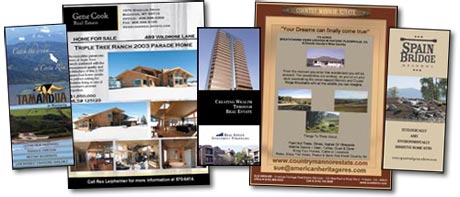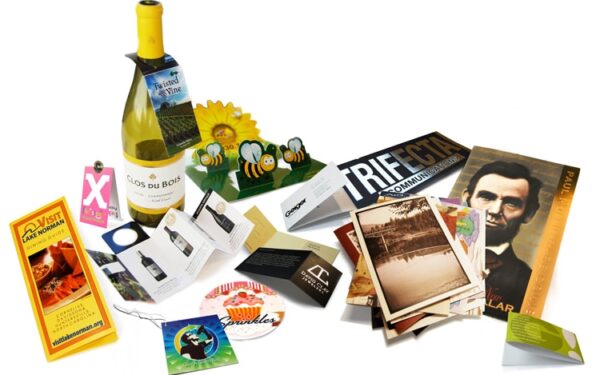Real Estate Marketing Tips
Real Estate Marketing Myths
1. Real estate is all about word of mouth, my past clients and my current listings market for me.
Word of mouth is the best form of advertising, but it’s rarely enough. Even if you have a strong referral base in your favor, if you aren’t keeping a moving stream of new customer leads, you’re at risk when the tides change in your competitive environment. You can’t afford not to spend on advertising if you’re banking on long-term viability for your business.
- Marketing doesn’t have to be expensive. business cards, for example, are one of the most cost-effective print marketing tools. Think of them as miniature ads and maximize the ‘real estate’ on your cards. You can use the back to print to provide useful info and calls to action, such as testimonials and free offers. Or use creative magnetic business cards to stay in front of your prospects every time they hit the fridge! To get a fast start, check out our easy online Business Card Templates.
- When promoting your existing listings, make your printed real estate flyers and brochures work harder for you. Showcase not only the property, but your services as well – what you offer to sellers and/or buyers. You’ve seen how many people stop by and pick up real estate flyers out of curiosity, even if they’re not currently in the market. Those are your future customers, make an impression both in person and on paper.
- Do stay in touch with your customer base in thoughtful and creative ways that encourage them to keep you in mind and refer you to friends. Send personal or useful gestures such as holiday greeting cards, notepads or mini-calendar magnets. Follow up with buyers after closing to welcome them to their new home.
2. The more exposure you get, the better.
Think you need to get your face plastered on billboards, in newspapers and in other media with your ads to get listing and buyers? Think again. Effective real estate marketing is not about getting in front of more people more often, it’s about getting in front of the right people in the right way.
What is your target audience? Are you focused on a particular neighborhood, demographic or income level? Use the right medium and messaging that reflects your unique value proposition and your target market. A combination of print and internet exposure is critical for an integrated marketing strategy.
- Done right, direct mail real estate postcards can be a powerful sales-booster with cost/benefits you can easily measure. Learn how to build a successful mail campaign and calculate your ROI with our Direct Mail Tips and our affordable Mailing Services and Direct Mail Lists. Use the new Every Door Direct Mail® Program or EDDM® to reach specific cities, zip codes, carrier routes or geographic areas cheaply.
- Surveys have shown that more than 70% of sellers and buyers use the first realtor they contact. Give prospects a reason to contact you or visit your website now. On your business cards, postcards, door hangers or flyers, point to resources on your site that are useful anytime such as local real estate updates, free home valuation service, home maintenance checklists or a blog for issues in your target neighborhoods.
3. You can’t compete with the “big guys” marketing budgets or more experienced agents.
This is a fallacy in every industry. In fact, you can compete well if you consider what do that the larger brokerages or long-time realtors don’t offer. Do you send new listings by email to buyers or share your clients’ environmentally-responsible practices, such as using sustainably-produced paper for your printed marketing and contract documents? Or maybe you exclusively work with buyers. Zero in on the advantages you provide or could offer that will distinguish you and get the message across in the cost-effective ways we’ve mentioned here.
More than most industries, real estate is about building trusted relationships. Find out what your target market cares about most and explain how you are a good fit for their needs. Don’t be hesitant to tout your accomplishments and ask for your customers’ business. The more honest, confident and competent you come across, the more trust you’ll earn and the better your chances for riding out the storm of any downturn.









 From the material you’ve gathered, you see that your average customer is between 18 and 35 years old, earns an income of between $22,000 and $35,000 and works, but doesn’t live within walking distance of your business.
From the material you’ve gathered, you see that your average customer is between 18 and 35 years old, earns an income of between $22,000 and $35,000 and works, but doesn’t live within walking distance of your business. Brochure marketing can be a daunting task for many business owners and industrious entrepreneurs, but it doesn’t have to be. A straightforward approach, some solid design, compelling layout and messaging, and getting your brochure in front of potential customers is the goal. Marketing your business with brochures is really about hitting the right people, with the right message, at the right time.
Brochure marketing can be a daunting task for many business owners and industrious entrepreneurs, but it doesn’t have to be. A straightforward approach, some solid design, compelling layout and messaging, and getting your brochure in front of potential customers is the goal. Marketing your business with brochures is really about hitting the right people, with the right message, at the right time.